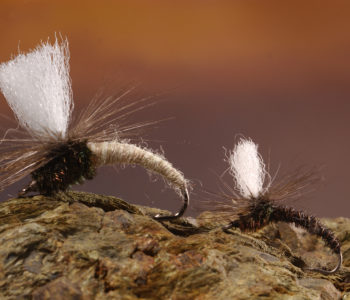
The Fragile Darters Story
THE FRAGILE DARTERS
A special fly by: Leon Links and Hans van Klinken
This is one of a series of European flies, which have done very well in several parts of the world. These unusual flies are fished differently and are developed with special thoughts behind them. Leon Links, a real fishing pal and close friend is they originator of ‘The Crazy Sedges’. When I saw Leon using them I knew directly that he is a real expert in fishing extremely large sedge patterns. The Crazy Sedges are often treated disbelievingly by others, but they are simple patterns with an enormous power to attract fish. Leon and I both build up our fishing skills in Scandinavia and we are used to fishing with extremely large flies for grayling and trout, flies that are big enough to use for salmon too. It is a unique series of flies but useless unless you know how to use them. Today Leon’s Crazy sedge and variations are among my personal favourites for trout, salmon and sea trout.
THE ARISING OF THE FRAGILE DARTERS
The first Crazy Sedge was developed in 1989 during one of Leon’s trips to the River Glomma in Norway. In that period he did a lot of experiments with all kinds of deer hair and discovered by accident that reindeer or caribou hair was much better and easier to work with than the stiffer deer or elk hair. After some experimentation, Leon produced a simple, unattractive pattern very similar to the Elk hair Caddis from Al Troth. The wing though, is much slimmer because the difference in material and is twice as long, resulting in a total different silhouette. The fact that Leon cut the fibres at the bottom of the fly gives also another appearance to his creation. In this stage I became involved in his series. I prefer a dry fly to float in the surface film instead of bobbing on the surface, and much experimentation with several species has proved to my satisfaction that it is important. When Leon and I put our tying efforts together several new patterns arose and we decided to call the complete series “The fragile darters”.
The only disadvantage about those patterns is its fragility. The soft reindeer hair breaks very easily; but the flies are simple and quick to tie. In spite, I helped Leon with some improvements, we couldn’t find a tying technique to improve durability without loosing the effectiveness of the pattern, but badly beat up flies seemed to be unbelievably successful anyway. Leon and I believe that the silhouette and mobility are the two most important facts that lead to those pattern successes. In our opinion it is only possible to use soft reindeer hair for the wing. We have taken a lot of fish with it when other fishermen were failing completely, and very large fish at that. The darters are killers and superb fish finders.
THE FISHING TECHNIQUES
We normally start by fishing all the patterns dead drift. If that doesn’t work we stimulate the fish to rise by holding the rod high so the fly leaves a wake. If that doesn’t work, we generate more movement by gently pulling the fly upstream. Very selective stale or “educated” fish are seduced very often by letting the fly float to six feet or so ahead of the lie, then the fly is pulled under and worked across the salmon’s or trout nose with little movements. If floating techniques have failed, this method can be deadly. We believe that the long, soft reindeer hair produces an enticing pulsing effect.
Over the years we have determined that the Fragile Darters are most successful in windy, sunny conditions when, because of the length of the wing, the flies really dance on the surface. To provide the best mobility and silhouette it is very important to present the fly with the wing almost in vertical position. So if the fly floats with the wing flat on the water you just make a new cast. We dry the flies carefully with amadou and use just a little floatant to provide water logging.










